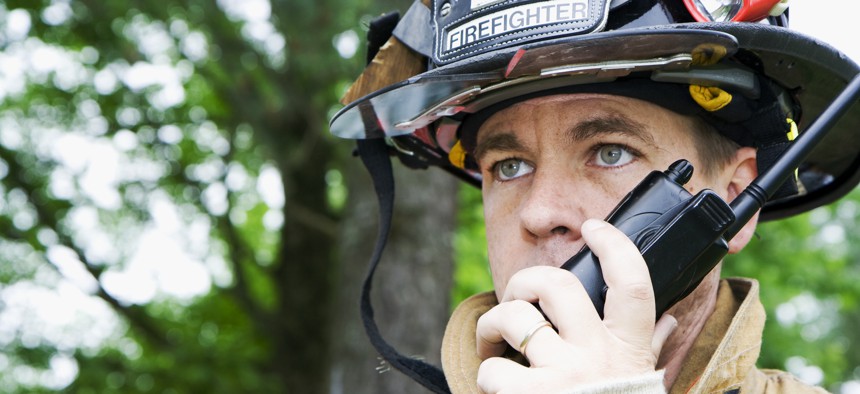What responders really want from their tech

racheldonahue/Getty Images
Communications technology is going to sit on the shelf if it’s not reliable, interoperable and user friendly.
What are first responders looking for in communications technology? According to authors of a recent study, the No. 1 answer was simply technology that works.
Researchers at the National Institute of Standards and Technology (NIST) spent five years studying quantitative and qualitative responses from 7,182 responders nationwide as part of “Voices of First Responders” project. The study, the largest to look at public safety end users’ experiences, cuts across four disciplines: police, fire, emergency medical and 911 dispatch responders.
“It really highlights three main areas that people need to be considering when they are building or developing or purchasing communication technology for first responders,” said Yee-Yin Choong, a human factors scientist in NIST’s Visualization and Usability Group of the Information Technology Laboratory and a report author. “It has to be reliable—working when they need it to work as intended. So, trustworthy technology. [Second,] the end user needs to be in control of the devices they’re supposed to use. And then user frustration. If you can take care of the former two—trustworthy technology and user control—you have happier end users, less frustrated users.”
No single technology emerged as particularly helpful or unhelpful, but a few themes bubbled up. For instance, across the responder disciplines, radio was the most useful, but its criticality varied depending on responder type. For instance, firefighters called radios their lifeline, but law enforcement officers said smartphones are more important. At the same time, many aren’t provided with devices, so they use their personal ones, which can be problematic.
For 911 personnel, the most important communications technology is software that helps them pinpoint callers’ exact location, but at the same time, they said their biggest challenge is pinpointing callers’ exact location, Choong said.
Ultimately, the message was that “if this isn’t useful for me and my job or we can’t use it to communicate or if it’s not interoperable with everything we already have and already are using, then it’s going to sit on the shelf,” said Shanée Dawkins, a computer scientist in the Visualization and Usability Group and a report author.
One common request that came up is for single sign-on, Choong added. Responders who are en route or working an incident often have trouble entering their passwords to login to various applications. “Believe it or not, they have to—often multiple times in a shift.”
As for pain points, the two main ones are coverage—including dropped communications and coverage gaps—and cost.
“Cost is huge because especially rural areas, they tend to have less resources and less access to this technology and then limited budget,” Choong said. “It’s not just upfront costs. Even if you’re able to buy whatever, it means money and resources to keep it operational and functioning.”
In fact, use and effectiveness of communications technology in rural vs. urban areas showed a statistical significance. Responders in rural areas tended to have fewer resources, less access to technology and limited budgets.
Interestingly, the report found no statistical significance between younger and older users. Although younger users were usually more comfortable with modern technology, when they lost access to it, problems came up. For instance, they struggled with paper maps when they lost access to GPS, Choong said.
Using the study data, the researchers developed six guidelines for future technology development. First, improve current technology, rather than develop new tech. Choong said that some responders said, “We’re not Christmas trees, don’t keep putting devices on us.”
Second, reduce unintended consequences. Although a technology might seem game-changing, in practice, it might impede responders’ ability to do their jobs by causing a distraction or forcing them to take an extra step, such as logging in or turning on a device.
The third guideline is recognizing that one size doesn’t fit all. “You can’t make the same thing for every first responder in every discipline,” Dawkins said.
That plays into the fourth guideline, which is to minimize technology for technology’s sake. “Don’t just make cool stuff,” she said. “Make sure you really listen to the voices of first responders and cater to their needs.”
The final two are lowering product or service costs and requiring that technology be usable.
“Voices of First Responders” started with interviews of 200 responders. With those results, researchers developed a more detailed survey about specific technologies, including radios, laptops, smartphones and headsets. The results have informed 14 publications: four NIST Special Publications, each focusing on one discipline, and 10 NIST Interagency Reports.
The themes have remained consistent throughout the five-year study, both Choong and Dawkins said, with no surprises popping up.
“The six principles … were actually part of our first report,” Dawkins said, adding that those issues have remained throughout the entire five-year project. “The survey results really confirmed what we heard in the interviews,” she said.
Choong said the research phase of the project is now complete, and the publications are focused on what she calls knowledge transfer. To that end, the researchers have made the anonymized interview and survey data public that anyone can use to inform research, product development and procurement.
Stephanie Kanowitz is a freelance writer based in northern Virginia.





